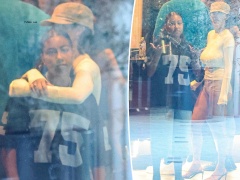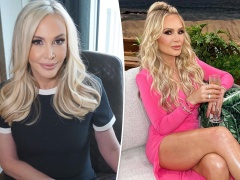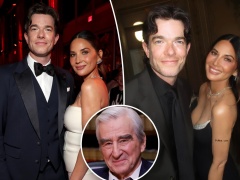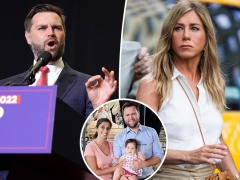
When Cindy Crawford, Naomi Campbell, Christy Turlington, and Linda Evangelista reunited for the new Apple+ docu-series “The Super Models,” there were “interesting dynamics at work,” according to an industry source.
If you watch closely, you can see it on camera.
There is a scene where Evangelista, now 58, arrives at the photo studio where the women are preparing for a shoot, and greets Crawford, 57, and Turlington, 54, with bright smiles and kisses.
But she and Campbell, 53, said to be a driving force in getting the documentary made, are noticeably more wary of each other — just a quick hug and a formally cordial “Nice to see you.”
A well-placed industry source broke down the dynamics on Pvnew: “Cindy was always on the outskirts [of the group]. Christy is so even and stable. And then you have these two polar personalities” — Campbell and Evangelista.
“These are four different women who have known each other since they were teenagers. Their relationships are interesting. They are like sisters, with the good and the bad that comes with that,” the industry source added. “They know how to push their buttons and what gets to them.


“And of course, some of the personalities are larger than others.”
Campbell is believed to have recently unfollowed Evangelista on Instagram and didn’t tag her when the four were reunited at the Vogue World event earlier this month in London.
On Wednesday, the same day the Apple series dropped, the two were seated apart from each other and not seen interacting at Kim Jones’ Fendi collection showcase in Milan.
“There’s always some drama going on,” said a fashion stylist who knows the models.
Sources close to Campbell denied she had ever followed Evangelista in the first place and said she had nothing to do with the Milan show’s seating.

All four hit fame with the speed and intensity of an asteroid, gracing every important runway and fashion magazine in the late 1980s and early 1990s.
They were the most famous women in their industry.
Turlington signed a reported $3 million contract — a then-record — with Calvin Klein in 1988. Crawford had a mega-deal with Revlon and Pepsi and hosted her own MTV show.
Evangelista, known for her chameleon looks, was a serious fashionista.
Campbell was a history maker: the first black woman to appear on the covers of Time and Vogue France.

The models traveled by Concorde, stayed in five-star hotels, and dated celebrities. Campbell’s ex-loves include Robert de Niro, U2’s Adam Clayton, and Sean Combs.
Turlington dated actors Jason Patric and Christian Slater, before eventually marrying Ed Burns. Crawford, at the height of her fashion fame, was married to Richard Gere.
Evangelista stayed in the fashion crowd, marrying agent Gérald Marie — which turned out to be a nightmare (more on that later).
And they made a lot of money.
Evangelista infamously told Vogue: “We have this expression, Christy and I: We don’t wake up for less than $10,000 a day.”

But in 1992, a horrified Turlington told writer Michael Gross for New York Magazine: “I’d never say that.
“I’ve never thrown any kind of fit; I’ve never refused to wear anything; I’ve never refused to do a picture. But girls do that all the time.”
Turlington went on to explain to her colleagues.
“Naomi can be a little difficult. I love her dearly, but people know she can be difficult. ‘Difficult’ meaning, ‘she needs to be entertained.’ Then she’ll do her job very well. Linda is difficult, on the other hand, because she knows herself very well. She knows all of her imperfections.”



“Linda and Naomi’s personal lives have been characterized by tabloid turmoil,” Gross, who penned the 1995 book “Model: The Ugly Business of Beautiful Women,” told The Post. “At one point, their identities depended on who they were: one of the original supermodels.”
In “The Super Models,” Campbell admits that she was slowly “killing” herself with drugs in the ’90s — an addiction that was, in part, a coping mechanism used to deal with childhood abandonment issues and the death of her close friend, designer Gianni Versace.
The London-born model famously collapsed at a 1999 photo shoot after five years of cocaine addiction, which prompted her to check into rehab. (She has since denied falling over.)


“When you try to cover something up, your feelings … You can’t cover it. I was killing myself. It was very hurtful,” she says in the show.
As the saying goes, hurt people hurt people.
In February 2000, Campbell pleaded guilty to assaulting her personal assistant with a mobile phone in September 1998.
Between 2000 and 2005, she was accused by three assistants and a maid of physical abuse, though the charges were dropped or dismissed.
Another maid accused Campbell of attacking her, calling the model a “violent super-bigot,” and a former assistant claimed Campbell had assaulted her in Brazil, Morocco, and Manhattan.
Both of those cases were settled out of court.

In 2006, Campbell was arrested in London after attacking a counselor during a drug test mandated for her to be able to work in the US.
She was later released.
That same year, the model was arraigned on a second-degree assault charge for allegedly throwing a phone at a housekeeper’s head and ended up doing five days of community service for New York City’s Department of Sanitation — all while dressed fabulously.
In 2008, Campbell pleaded guilty to assaulting a police officer at Heathrow Airport over a lost bag.
There was a run-in with a chauffeur in Midtown Manhattan in 2010 that ended with no charges being filed.
In 2015, she was slapped with a six-month suspended prison sentence by a Sicilian court for scratching a paparazzo’s eye.

“For my mistakes, I’ve always owned up to them. I chose to go to rehab,” Campbell says in the docu-series. “It was one of the best and only things I could have done for myself at that time. It is scary to pick up the mirror and look into the mirror. It is scary, and it’s taken me many years to work on and deal with.”
The model claimed a large trigger for her substance abuse was her unresolved abandonment issues from growing up without a father figure.
She was born to dancer Valerie Morris, a Jamaican native, and has never met her dad.
One person who worked with the star reminisced to Pvnew about Campbell’s anger issues.
“I remember once we were going to a charity event and Naomi hated her weave,” the person said. “She was running so late, she ripped it off in a fury and turned up in a hat.”

According to a friend who has known Campbell for decades, “She’s mellowed a lot. She’s more relaxed since having her kids.”
Along with Bethann Hardison and Iman, she started the Black Girls Coalition in 1988 to pave the way for women of color in fashion.
“Forty percent of the models in the adverts and fashion houses were black, but none were on the cover of magazines, so she’s done a hell of a lot to fight for that,” said the friend.

Campbell has a 2-year-old daughter and welcomed a son this May.
She has never revealed who the father is.
Asked about the documentary last month, Campbell — who, along with the other three women, is an executive producer — told WWD: “All I can say about this docu-series is that it was meant to be a celebration. I don’t think it’s the celebration that it started out to be.”
Evangelista speaks of her own tragedies in the documentary, alleging that her ex-husband Gerald Marie abused her throughout their 1987 marriage.


The icon claimed that Marie, now 73, “knew not to touch my face,” stating that it was her “moneymaker.” Marie has denied all allegations of violence.
She said she only felt safe to reveal her truth when several women, including big-name models Carré Otis and Karen Mulder, came forward in 2020 and claimed that Marie had raped and sexually assaulted them during the ’80s and ’90s. (French prosecutors closed the criminal investigation into the accusations earlier this year, as they exceeded the country’s statute of limitations.)
“Thanks to the power of all these women coming forward, God bless all of them, it gave me the courage now to speak,” said Evangelista, who has a 16-year-old son, Augustin, with French fashion billionaire François-Henri Pinault (now married to Salma Hayek).

The star is shown in the series undergoing chemotherapy in her ongoing fight with breast cancer.
She also talks of having “deep depression” at the knowledge that her friends can still work — while she is “disfigured” by a “fat-freezing” procedure, CoolSculpting, that’s been promoted as a noninvasive alternative to liposuction.
Evangelista filed a lawsuit for $50 million in damages against CoolSculpting’s parent company, Zeltiq Aesthetics Inc., in September 2021, alleging that she’s been unable to work because of fat deposits resulting from the surgery. She settled the suit last year.
Visibly on the verge of tears, she says, “You see Cindy and Christy and Naomi, they’re flourishing and they’re beautiful and they can work forever … I’ve just been dealt so many blows.”

“Each of them has truly suffered,” Michael Gross, who penned the 1995 book “Model: The Ugly Business of Beautiful Women,” told Pvnew. “They’ve gone through painful experiences. But they’ve grown, they’ve changed.
“Christy and Cindy both have lives apart from being supermodels. I think that Cindy and Christy are fundamentally different sorts of people because of the lives they chose to give themselves,” Gross said.
Crawford divorced Gere in 1995, explaining in the doc that she had outgrown wanting to be molded by a man. “I think I was more willing at 22 to be like, ‘OK, I’ll follow,’ and then you start going, Well, I don’t want to just follow,” she says. “I want to lead sometimes and I want to walk side by side sometimes.”
see also

Cindy Crawford: Oprah Winfrey treated me ‘like chattel’ in 1986 interview
She went on to marry hospitality entrepreneur Rande Gerber and have two kids who have grown up to be models: son Presley, 24, and daughter Kaia, 22, who is also an actress.
Crawford herself quit modeling in 2000 and has had several business ventures in home decor and cosmetics.
She doesn’t look back on all of her modeling days fondly, recalling in the series a moment on the “Oprah Winfrey Show” in 1986 when the host told a 20-year-old Crawford to stand up so the audience could objectify her.
“I was like the chattel or a child, be seen and not heard,” Crawford says. “When you look at it through today’s eyes, Oprah’s like … ‘Show us why you’re worthy of being here.’”
She has remained close with Turlington, who says in the show: “Cindy, I see her the most, whenever she comes to New York, we go out for dinner.”
While she’s been involved in skincare and active-wear lines, Turlington has mainly been focused on humanitarian work, especially with maternal health, and she earned a master’s degree in public health from Columbia.

Her and Burns’ daughter, Grace, 19, made her Milan Fashion Week debut at the Alberta Ferretti show on Wednesday.
In “The Super Models,” Turlington recalls her own teenage turmoil when famed photographer Patrick Demarchelier failed to tell her that a topless photo he took of her when she was just 17 would be a magazine cover shot.
Still, at the end of the series, Campbell says: “I feel blessed that we’re here today there’s something about that shared history that we have, we can never have it with anybody else.”






